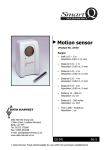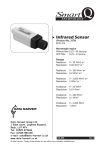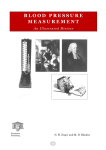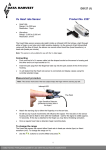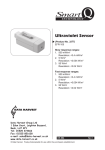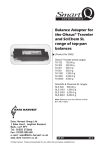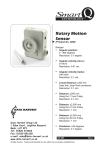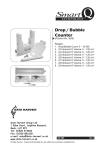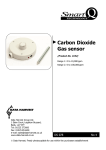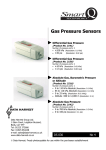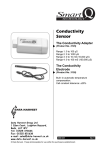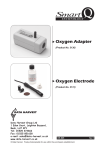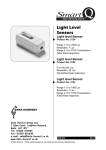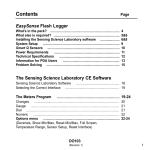Download Heart Rate Sensor
Transcript
Smart Q TECHNOLOGY Heart Rate Sensor Product No. 3147 Heart rate Range: 0 to 200 bpm Resolution: 1 bpm Waveform Range: -2000 to 2000 mV Resolution: 1 mV DATA HARVEST Data Harvest Group Ltd 1 Eden Court, Leighton Buzzard, Beds, LU7 4FY Tel: 01525 373666 Fax: 01525 851638 e-mail: [email protected] www.data-harvest.co.uk DS 033 © Data Harvest. Freely photocopiable for use within the purchasers establishment. No 4 Smart Q Heart Rate Sensors TECHNOLOGY Introduction The Smart Q Heart Rate Sensor monitors the light level transmitted through the vascular tissue of the fingertip or the ear lobe and the corresponding variations in light intensities that occurs as the blood volume changes in the tissue. The EASYSENSE unit can detect that the Smart Q Heart Rate Sensor is connected and the range it is set to. Connecting Smart Q label on top Insert jack plug of Pleth into jack socket Sensor cable with locating arrow facing upwards Hold the Heart Rate Sensor housing with the Smart Q label showing on the top. Push one end of the sensor cable (supplied with the EASYSENSE unit) into the shaped socket at the end of the Sensor housing with the locating arrow on the cable facing upwards. Connect the other end of the sensor cable to the Input socket on the EASYSENSE unit (with the locating arrow facing upwards). Insert the jack plug from the finger/ear lobe clip into the jack socket at the end of the Sensor housing. The EASYSENSE unit will detect that the Heart Rate Sensor is connected. If the currently selected range is not suitable for your investigation, set to the correct range. To set the range The Heart Rate Sensor can record either Heart rate, in beats per minute (bpm) or Heart waveform, in mV. Connect the Heart Rate Sensor to the EASYSENSE unit. Start the EASYSENSE program and select one of the logging modes from the Home page. Select Sensor Config from the Settings menu. Select the Heart Rate Sensor from the list (it will be listed using its current range) and click on the Change Range button. The current range will be highlighted. Select the required range and click on OK. Close Sensor Config. Click on New and then Finish for the change in range to be detected by the logging mode. 1 Smart Q Heart Rate Sensors TECHNOLOGY The range setting will be retained until changed by the user. With some EASYSENSE units it is possible to change the range from the unit. Please refer to the EASYSENSE unit’s user manual. Measurement procedure 1. Attach the finger/ear lobe clip (Pleth) to either the fingertip or to the ear lobe. Infrared LED The Pleth Note: Avoid applying pressure to the clip as this could affect the signal. 2. Stay reasonably still as any muscle movements Light Sensitive Detector will influence the signal. The red LED on the Sensor housing will start to flash in time with the heartbeat - wait for the signal to stabilise. If the clip is attached to the finger you may feel a throbbing sensation. Note: If the red LED doesn’t flash, and the LCD display on the EASYSENSE logger is blank, press any button on the panel of the EASYSENSE unit to wake it up. 3. Once a regular heart rate is detected, begin recording data. Background The Smart Q Heart Rate Sensor is used to measure the cardiovascular pulse wave that is found throughout the human body. This pulse wave will result in a change in the volume of arterial blood with each pulse beat. This change in blood volume can be detected in peripheral parts of the body such as the fingertip or ear lobe using a technique called Photoplethysmography. The device that detects the signal is called a plethysmograph (or ‘Pleth’ for short). The Pleth consists of: An infrared LED which illuminates the tissue. A light sensitive detector (LSD), which has been tuned to the same colour frequency as the LED, and detects the amount of light transmitted from the tissue. The Pleth supplied with this Sensor is a transmission mode plethysmographic signal (PPG) device, which uses transmitted light to estimate absorption. The infrared LED and the light sensitive detector (LSD) are mounted in a spring-loaded device that can be clipped onto the fingertip or ear lobe. Infrared LED The Pleth FingerVascular Vascular Bed Finger Bed Light Sensitive Detector The infrared light emitted by the LED is diffusely scattered through the fingertip or ear lobe tissue. A light sensitive detector positioned on the surface of the skin on the 2 Smart Q Heart Rate Sensors TECHNOLOGY opposite side can measure light transmitted through at a range of depths. Infrared light is absorbed well in blood and weakly absorbed in tissue. Any changes in blood volume will be registered since increasing (or decreasing) volume will cause more or less absorption. Assuming the subject does not move the level of absorption of the tissue and non-pulsating fluids will remain the same. A b s o r p t i o n L e v e l Absorption due to changes in arterial blood volume Absorption due to arterial blood Absorption due to venous blood Absorption due to bone tissue and skin Practical Information The amount of light that can be detected by the Light Sensitive Detector (LSD) will vary with each test subject and as to whether the clip is attached to a fingertip or ear lobe. When attached to a finger: Finger nail Position the finger clip so that the Light Sensitive The Detector is on the fleshy side of the finger. Pleth Fingers should be clean. Nail varnish may cause falsely low readings. Values should not be affected by skin colouring. Light Sensitive Detector Some subjects may have poor peripheral circulation (the extent to which the blood vessels in the fingertip are filled with blood), in which case another subject should be selected. If the heart rate does not seem to settle, try warming the hands by rubbing to increase the blood flow. If readings are lower than expected, try repositioning the clip to make sure firm contact is obtained. Attached to an ear lobe: Remove any earrings before attaching the finger/ear lobe clip to the ear lobe. The clip can be made more secure by hooking the wire round the back of the ear or by using the slide on the lead to attaching it to the subject’s clothing. If the heart rate does not settle or if readings are lower than expected, try repositioning the clip to make sure a firm contact is obtained. Each time the finger/ear lobe clip is attached to a fingertip or ear lobe, wait until the signal stabilises before starting to record data - the initial unstable signal will be due to compression from the clip being attached. 3 Smart Q Heart Rate Sensors TECHNOLOGY Stay reasonably still while recording data. Movement e.g. raising and lowering a hand, will alter the pressure the finger exerts on the clip whilst simultaneously causing a change in venous blood that will affect light transmission through the tissue. It is possible to alter heart rate by simply decreasing respiratory rate. Encourage the test subject to breath normally. The number of beats per minute is calculated by the Heart Rate Sensor by timing the width of a pulse and ‘scaling up’ to a rate of beats per minute. For example, a recorded wave form of a 0.7 second duration would become (1 ÷ 0.7) x 60 = 85.7 beats per minute. Sporadic short or longer beats will produce artificially high or low readings. This should not present a problem as trends in heart rate are studied, not absolute values or rapid changes. The heart rate is averaged over every five beats to achieve a smoother reading. If the finger/ear lobe clip ‘loses contact’ with the pulse, the Sensor will attempt to re-establish communication. This may result in the reading momentarily dropping to zero. Heart rate (bpm) 200 180 160 140 120 It is possible for the dicrotic notch to be recorded as a separate pulse, and so give higher readings than expected. The effects are more noticeable if the clip is attached to the finger; try using with the clip attached to the ear lobe. } Contact lost 100 This Sensor is not intended for medical diagnosis. Do not be alarmed if results do not correspond to quoted numbers. These numbers represent typical averages and many healthy hearts have data that falls outside these parameters. It is quite normal for the heart to occasionally miss a beat. 80 60 Communication re-established 40 20 0 0:0 Heart wave (mV) 2000 22:5 45.0 Time (s) 67.5 90.0 Heart waveform of a subject with a significant dicrotic notch 1500 dicrotic notch 1000 500 0 2.90 seconds 5.07 seconds 7.25 seconds -500 -1000 -1271 This Sensor is not waterproof. Clean the clip by wiping with a cloth that has been rinsed in disinfectant. Example of depth of dicrotic notch that may affect Heart Rate data The light sensitive detector (LSD) in the clip can be sensitive to high levels of ambient infrared light e.g. strong sunlight. If this maybe the case try excluding the light by covering the clip with some dark fabric e.g. by placing your hand inside a cloth bag. 4 Smart Q Heart Rate Sensors TECHNOLOGY The fastest speed that the Heart Rate Sensor can be used with to capture data is 50Hz (20ms). If an intersample time of less than 20 milliseconds is selected, then the values obtained will default to zero. Heart rate Blood passes through the heart in two phases that alternate continuously. Diastole (heart expanding) Systole (heart contracting) The muscles of the ventricles relax The muscles of the ventricles contract The atrio-ventricular valves open The atrio-ventricular valves close The arterial valves close The arterial valves open Blood flows from atria into ventricles Blood flows from the ventricles into arteries The blood forced into the aorta during systole moves the blood in the vessels forwards and sets up a pressure wave that travels along the arteries. This pressure wave expands the arterial walls as it travels and is felt as the pulse. The pulse may be felt at points where arteries pass over bones, known as pressure points e.g. in the wrist and neck. Pulse rate is a direct measure of the number of heart cycles in a minute (heart rate). Heart rate can vary with age as shown below: Average heart rate (beats per minute) Age Newborn 140 7 years 85 – 90 14 years 80 – 85 Adult 70 – 80 In normal healthy individuals the heart rate, and thus the pulse rate, varies with the phases of respiration. Irregular changes in heart rate occur in all people. Heart rate may be increased by exercise, nervous excitement, stress due to mental effort, by adrenaline entering the bloodstream or with increase in temperature caused by fever. The heart rate decreases when asleep and some medical conditions may also cause a drop. Following exercise it takes a while for the heart rate to return to resting level. This is the recovery time and gives an indication of the fitness of the individual. Recovery time may vary from less than five minute in very fit individuals to around 15 minutes. 5 Smart Q Heart Rate Sensors TECHNOLOGY Safe Pulse rates During experiments the safe heart rate should not be exceeded. The safe level is given as the maximum heart rate for age, minus 20 beats per minute. Maximum heart rate = 210 – (0.65 x age) Age Maximum heart rate Safe heart rate 12 202 182 13 202 182 14 201 181 15 200 180 16 199 179 17 199 179 18 198 178 It is important that investigations do not become a competition. Consider any possible health problems before selecting the subject. Waveform The heartbeat recorded by the Smart Q Heart Rate Sensor is smoothed by the passage of blood through the capillaries and the pressure signal does not resemble the pulse seen in an electrocardiogram (which is used to record the hearts electrical activity). However, the periodicity of the signal is unchanged and the Heart Rate Sensor can be effectively used to detect changes in heart rate. The upstroke, called the anacrotic limb, is abrupt and is due to contraction of the ventricle (systole). The downstroke is more gradual and corresponds to the elastic recoil of the arterial walls. The downstroke regularly shows a fluctuation known as the dicrotic notch. This is due to vibrations set up when the aortic valve snaps shut – it has no major significance as an indicator of health. 2000 Dicrotic notch 1500 Anacrotic limb 1000 500 0 1250 2500 3750 5000 -500 -1000 -1500 1 second -2000 Time (ms) For a healthy person at rest, the heart beats on average at about 60 beats per minute or one a second i.e. around 1Hz. This frequency is not constant (even in a healthy individual at rest). It takes approximately one second to record a complete wave, so it is usually best to select a short recording time. 6 Smart Q Heart Rate Sensors TECHNOLOGY Investigations Heart rate (bpm) 200 180 160 Exercise (while sitting) 140 120 100 80 60 40 Sitting Recovering 20 0 00:00.0 00:15.0 00:30.0 00:45.0 01:00.0 Monitoring fitness - after exercise pulse is timed until it gets back to the normal standing heart rate (this can be achieved by remaining in a sitting position and moving the legs). Monitoring resting. Changes with mild stimulants (cups of coffee or cola – might show less effect on people who are accustomed to large amounts of caffeine). Variation in blood flow i.e. people who suffer with cold fingers will show a very low blood flow in their veins – try warming their hands. Investigating pulse rate with different body positions (sitting, crouching, standing, laying down). The effect of music on pulse rate. The effect of the strictest teacher entering the room! Warranty All Data Harvest Sensors are warranted to be free from defects in materials and workmanship for a period of 12 months from the date of purchase provided they have been used in accordance with any instructions, under normal laboratory conditions. This warranty does not apply if the Sensor has been damaged by accident or misuse. In the event of a fault developing within the 12-month period, the Sensor must be returned to Data Harvest for repair or replacement at no expense to the user other than postal charges. Note: Data Harvest products are designed for educational use and are not intended for use in industrial, medical or commercial applications. WEEE (Waste Electrical and Electronic Equipment) Legislation Data Harvest Group Ltd are fully compliant with WEEE legislation and are pleased to provide a disposal service for any of our products when their life expires. Simply return them to us clearly identified as ‘life expired’ and we will dispose of them for you. 7








